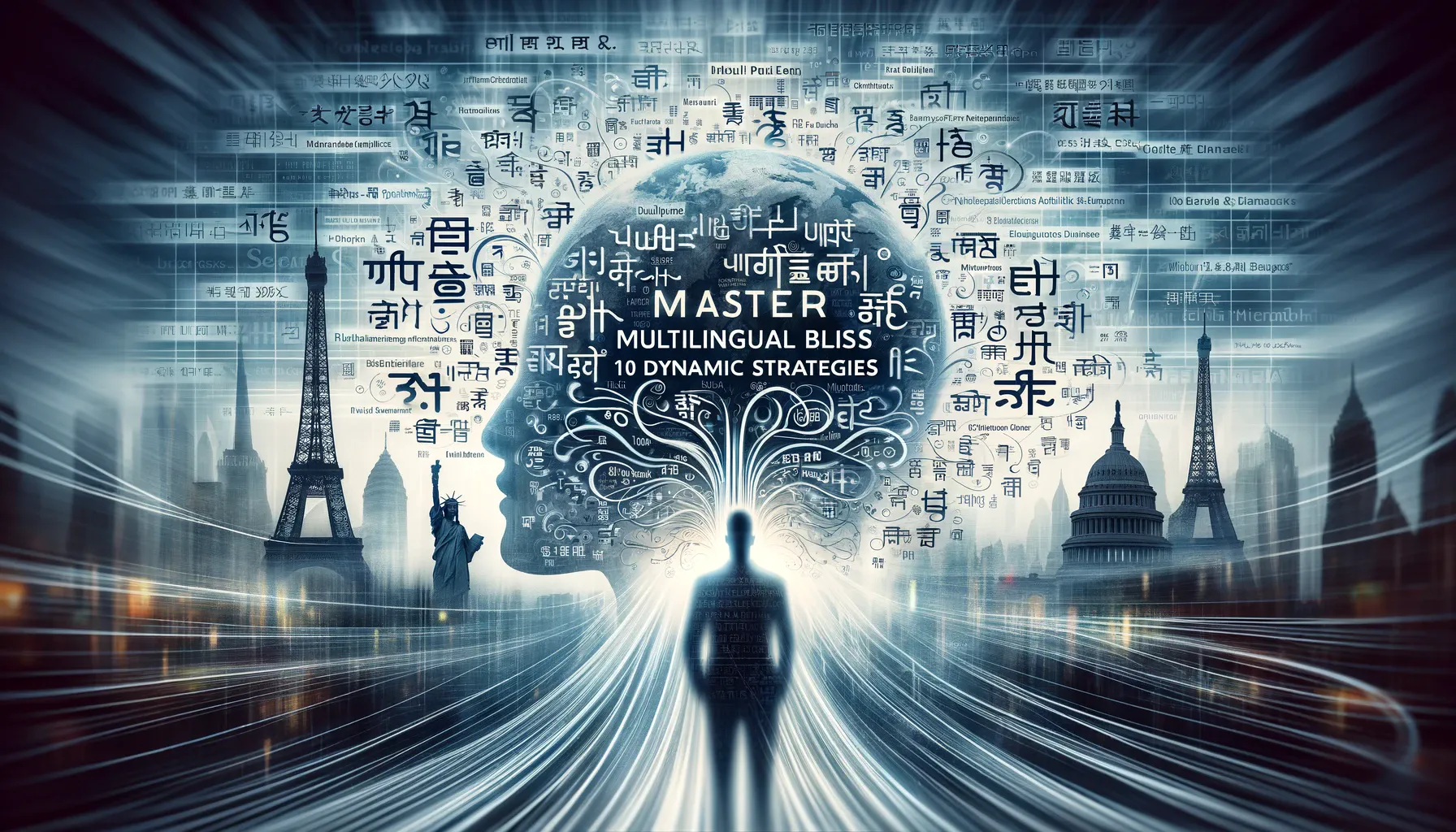Google Translate Mastery: 10 Dynamic Strategies for Multilingual Communication Bliss
Table of Contents
Google Translate is a machine translation service developed by Google that allows users to translate text, speech, images, or real-time video from one language to another. It uses a combination of artificial intelligence, machine learning, and statistical algorithms to provide translations. In the vast landscape of global communication, Google Translate stands as a beacon, bridging linguistic divides and opening doors to a world of multilingual possibilities. With its ever-evolving capabilities, mastering Google Translate becomes an invaluable skill for individuals and businesses alike.

In this exploration, we delve into the heart of this linguistic marvel, unveiling ten dynamic strategies that promise to elevate your multilingual communication experience to a state of bliss. From harnessing the power of Neural Machine Translation to navigating the intricacies of real-time translation, this journey promises insights that transcend language barriers, offering a profound understanding of how Translator by Google can be wielded as a powerful tool for seamless and meaningful interactions across the globe.
Google Translate Features: Bridging Language Gaps
Translation Methods: Google Translate offers diverse translation methods to cater to various communication needs. In text translation, users can input written content in one language, and the tool seamlessly generates an equivalent text in the desired target language. Speech translation takes communication a step further, allowing users to verbally express themselves into the microphone. The app then converts the spoken words into text and provides a translation, enabling real-time multilingual conversations.
The image translation feature also extends the tool’s capabilities to visual content. Users can capture text from images, such as signs or menus in a foreign language, and the Translator by Google promptly delivers an accurate translation, making it a versatile solution for overcoming language barriers in both written and spoken forms.
Neural Machine Translation (NMT): Google Translate employs Neural Machine Translation, a deep learning-based approach that considers the context of entire sentences rather than translating word by word. This leads to more coherent and contextually accurate translations.
Supported Languages: Google Translate supports a vast number of languages, including popular languages like English, Spanish, French, German, Chinese, Japanese, and many others. It also supports less common languages, though the accuracy may vary.
Web Interface and Mobile App: Users can access Translator by Google through a web browser on their computers. Additionally, there is a dedicated Google Translate mobile app available for Android and iOS devices.
Real-time Translation: The app supports real-time translation using the device’s camera. This feature allows users to point their camera at printed text (like a street sign or menu), and the app will overlay the translated text on the screen.
Phrasebook: Google Translate offers a phrasebook feature that allows users to save commonly used phrases for quick access. This can be especially useful for travelers or individuals who frequently communicate in multiple languages.
Offline Mode: The mobile app supports offline mode, enabling users to download language packs for specific languages. This is handy when traveling to areas with limited or no internet connectivity.
User Contributions: Translator by Google allows users to contribute their translations and suggest corrections. This crowd-sourced approach helps improve the quality of translations over time.
AutoML and Continuous Learning: The service uses AutoML and machine learning techniques for continuous learning. It learns from user feedback, corrections, and new language data to improve translation accuracy.
Synonyms and Contextual Understanding: Google Translate aims to understand the context of a sentence to provide more accurate translations. It takes into account synonyms, idioms, and contextual nuances to enhance the quality of the translated text.
Google Translate is a versatile tool that uses advanced technologies to break down language barriers, enabling users to communicate effectively in multiple languages through various input methods. It continues to evolve with updates and improvements, making it an essential resource for individuals and businesses worldwide.
Master Multilingual Bliss: 10 Dynamic Strategies
In today’s interconnected world, effective communication across languages is more critical than ever. Whether you’re a traveler, business professional, or language enthusiast, Translator by Google stands as a powerful tool for breaking down language barriers. This article explores the art of harnessing the full potential of Google Translate, unveiling 10 dynamic strategies that promise to elevate your multilingual communication experience to a state of bliss.

- Embrace Neural Machine Translation (NMT):
- Neural Machine Translation (NMT) lies at the heart of Google Translate’s functioning. It is a sophisticated approach that considers entire sentences rather than translating word by word. By understanding the context, NMT enhances translation accuracy, resulting in more coherent and contextually meaningful translations that surpass traditional word-for-word conversions.
- The Power of Context:
- Context awareness is a crucial feature of Google Translate. This aspect allows the tool to comprehend the context of a sentence, navigating through nuances and idiomatic expressions. The result is more accurate and authentic translations that resonate appropriately in any language, capturing the intended meaning behind the words.
- Optimize Image Translation:
- Google Translate’s image translation feature is a marvel. It enables the interpretation of text from images, offering real-time translations for signs, menus, and various printed materials. This functionality proves invaluable for users seeking an immediate understanding of foreign language content in their surroundings.
- Real-Time Translation with Camera Mode:
- The camera mode in Google Translate facilitates real-time translation by overlaying translated text onto the camera feed. This practical feature provides instant comprehension of foreign language text, making it a handy tool for on-the-spot translation needs in diverse environments.
- Speech-to-Text Magic:
- Google Translate’s speech-to-text feature is a powerful tool for those who prefer verbal communication. By articulating thoughts verbally, users can witness the tool seamlessly converting spoken words into accurate, written translations. This feature is particularly useful for hands-free communication and language learning.
- Offline Language Packs for On-the-Go Access:
- Google Translate’s offline mode enhances convenience by allowing users to download language packs. This feature ensures seamless translation capabilities even in areas with limited or no internet connectivity, making it a reliable companion for on-the-go communication.
- Building Your Phrasebook:
- The creation of a personalized phrasebook is a key strategy for efficiency in multilingual interactions. By saving commonly used phrases, users can streamline communication, whether traveling or engaging with an international audience. This feature facilitates quick access to frequently needed expressions.
- Harnessing AutoML for Continuous Improvement:
- Google Translate employs AutoML for continuous learning. This involves the system adapting and improving based on user contributions and corrections. The insights gathered through AutoML play a pivotal role in refining the translation model over time, ensuring ongoing enhancement in accuracy.
- Multilingual Business Strategies:
- Translator by Google offers strategic solutions for businesses aiming to expand globally. From website localization to implementing multilingual customer support, businesses can seamlessly integrate Google Translate into various processes. This enables effective communication and engagement with diverse audiences.
- Beyond Language Barriers:
- The journey concludes by envisioning a world where language ceases to be a barrier. Google Translate plays a role in fostering global understanding, collaboration, and unity through effective multilingual communication. It transcends linguistic limitations, opening up possibilities for enhanced connections and cooperation on a global scale.
Google Translate Rivals: Exploring Alternatives
Several translation services can be considered competitors to Google Translate. Here are some notable ones:
- Microsoft Translator:
- Developed by Microsoft, this service provides translation for text, speech, and images. Its versatility extends across different platforms, making it accessible to a wide range of users. Microsoft Translator supports a variety of languages, enhancing its applicability in diverse scenarios.
- DeepL:
- Known for its exceptional neural machine translations, DeepL stands out for the high quality and accuracy of its language processing. Its support for multiple languages and the ability to generate natural-sounding translations make it a preferred choice for users seeking top-notch translation services.
- Systran:
- Systran is a language technology software company catering to businesses and individuals. Its machine translation solutions cover a wide range of industries, providing specialized translation services. Systran’s focus on industry-specific needs sets it apart in the translation service landscape.
- Bing Translator:
- As part of the Microsoft ecosystem, Bing Translator is seamlessly integrated into the Bing search engine. It encompasses text and website translation services, offering users a comprehensive language translation experience within the broader Microsoft environment.
- Translate.com:
- Translate.com is a versatile platform offering both professional and community-based translation services. Users have the flexibility to request human translations or opt for machine translation. This dual approach caters to a broad user base seeking different levels of translation accuracy.

Considerations:
- Users should be aware that the performance of these services may vary based on language pairs and specific contexts.
- Factors influencing the choice of a translation service include accuracy, language support, user interface, and integration capabilities with other applications or platforms.
- Each service has its strengths, and users may select a particular translation service based on their unique requirements and preferences.
Understanding the diverse features and focuses of these translation services allows users to make informed decisions based on their specific needs in multilingual communication.
A Blissful Conclusion to Google Translate Mastery
In the pursuit of multilingual communication bliss, the mastery of Google Translate emerges as a transformative skill, breaking down barriers and fostering connections across languages. Through the ten dynamic strategies unveiled in this journey, users embark on a path where language is no longer a hindrance but a gateway to shared understanding. From the nuanced awareness of context to the practicality of offline language packs, each strategy contributes to a comprehensive toolkit for effective communication.
As we conclude this exploration, envision a world where borders dissolve in the richness of diverse languages, and Google Translate stands as the compass guiding us toward multilingual harmony. Embrace the mastery of Translator by Google, and let the symphony of languages become the melody of global communication bliss.
Featured Insights
 The Future is Now: AI and ML Technologies Reshaping Healthcare
The Future is Now: AI and ML Technologies Reshaping Healthcare Introduction to Digital Twin Technology in Manufacturing with Unprecedented Efficiency and Innovation
Introduction to Digital Twin Technology in Manufacturing with Unprecedented Efficiency and Innovation Adobe’s Firefly AI: New Tools for Photoshop and Illustrator
Adobe’s Firefly AI: New Tools for Photoshop and Illustrator Introducing Meta Imagine Me: Your Digital Doppelganger
Introducing Meta Imagine Me: Your Digital Doppelganger AI in Gaming is Transforming the Industry
AI in Gaming is Transforming the Industry Gen AI Market Boom: A $1 Trillion Industry in the Making?
Gen AI Market Boom: A $1 Trillion Industry in the Making?